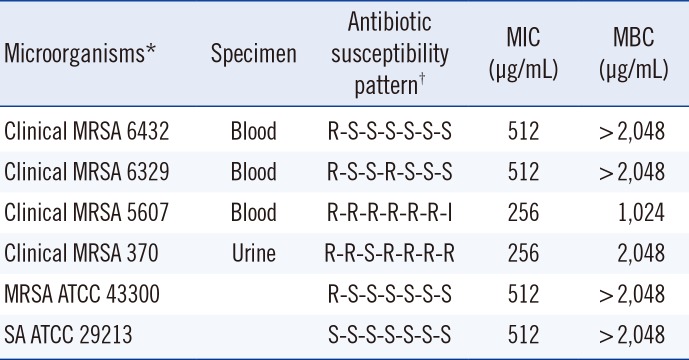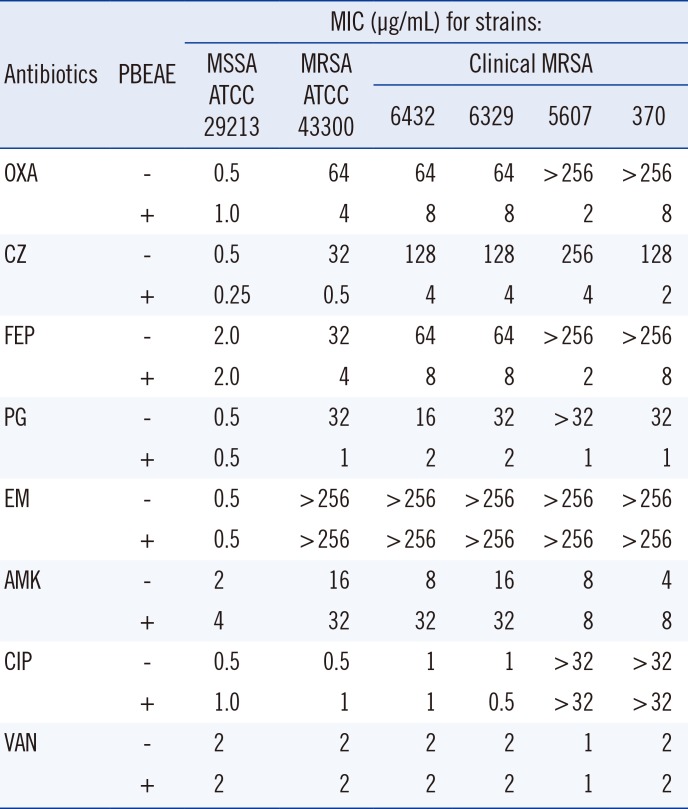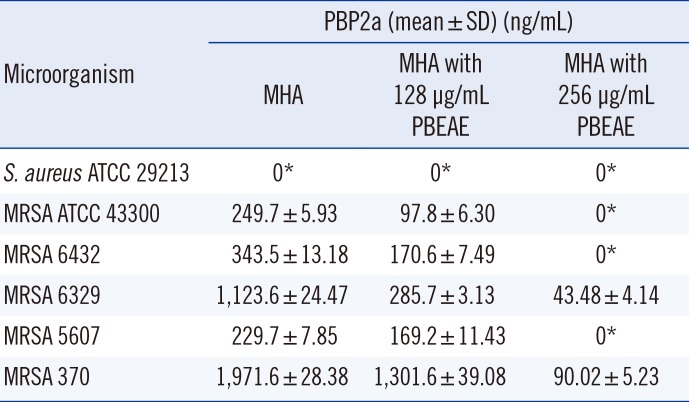1. "Celbenin"-resistant Staphylococci. Br Med J. 1961; 1:113–114. PMID:
14447241.
2. Rosenthal VD, Maki DG, Jamulitrat S, Medeiros EA, Todi SK, Gomez DY, et al. International Nosocomial Infection Control Consortorium (INICC) report, data summary for 2003-2008, issued June 2009. Am J Infect Control. 2010; 38:95–104.e2. PMID:
20176284.
3. Chambers HF. The changing epidemiology of
Staphylococcus aureus? Emerg Infect Dis. 2001; 7:178–182. PMID:
11294701.
4. Lee K, Kim MN, Kim JS, Hong HL, Kang JO, Shin JH, et al. Further increases in carbapenem-, amikacin-, and fluoroquinolone-resistant isolates of
Acinetobacter spp. and
P. aeruginosa in Korea: KONSAR study. Yonsei Med J. 2011; 52:793–802. PMID:
21786445.
5. Courvalin P. Vancomycin resistance in gram-positive cocci. Clin Infect Dis. 2006; 42(S1):S25–S34. PMID:
16323116.

6. Friedman L, Alder JD, Silverman JA. Genetic changes that correlate with reduced susceptibility to daptomycin in
Staphylococcus aureus. Antimicrob Agents Chemother. 2006; 50:2137–2145. PMID:
16723576.
7. Tsiodras S, Gold HS, Sakoulas G, Eliopoulos GM, Wennersten C, Venkataraman L, et al. Linezolid resistance in a clinical isolate of Staphylococcus aureus. Lancet. 2001; 358:207–208. PMID:
11476839.

8. Mahady GB. Medicinal plants for the prevention and treatment of bacterial infections. Curr Pharm Des. 2005; 11:2405–2427. PMID:
16026296.

9. Gibbons S. Anti-staphylococcal plant natural products. Nat Prod Rep. 2004; 21:263–277. PMID:
15042149.

10. Hemaiswarya S, Kruthiventi AK, Doble M. Synergism between natural products and antibiotics against infectious diseases. Phytomedicine. 2008; 15:639–652. PMID:
18599280.

11. Shimizu M, Shiota S, Mizushima T, Ito H, Hatano T, Yoshida T, et al. Marked potentiation of activity of β-lactams against methicillin-resistant
Staphylococcus aureus by corilagin. Antimicrob Agents Chemother. 2001; 45:3198–3201. PMID:
11600378.
12. Shiota S, Shimizu M, Sugiyama J, Morita Y, Mizushima T, Tsuchiya T. Mechanisms of action of coriligan and tellimagrandin I that remarkably potentiate the activity of β-lactams against methicillin-resistant
Staphylococcus aureus. Microbiol Immunol. 2004; 48:67–73. PMID:
14734860.
13. Hwang HJ, Kim SW, Xu CP, Choi JW, Yun JW. Morphological and rheological properties of the three different species of blasidiomycetes
Phellinus in submerged cultures. J Appl Microbiol. 2004; 96:1296–1305. PMID:
15139922.
14. Noh JR, Lee IK, Ly SY, Yang KJ, Gang GT, Kim YH, et al. A
Phellinus baumii extract reduces obesity in high-fat diet-fed mice and absorption of triglyceride in lipid-loaded mice. J Med Food. 2011; 14:209–218. PMID:
21332399.
15. Lee IK, Han MS, Lee MS, Kim YS, Yun BS. Styrilpyrones from the medicinal fungus
Phelinus baumii and their antioxidant properties. Bioorg Med Chem Lett. 2010; 20:5459–5461. PMID:
20708931.
16. Hwang HJ, Kim SW, Lim JM, Joo JH, Kim HO, Kim HM, et al. Hypoglycemic effect of crude exopolysaccharides produced by a medicinal mushroom
Phellinus baumii in streptozotocin-induced diabetic rats. Life Sci. 2005; 76:3069–3080. PMID:
15850599.
17. Kamruzzaman SM, Endale M, Oh WJ, Park SC, Kim TH, Lee IK, et al. Antiplatelet activity of
Phellinus baumii methanol extract is mediated by cyclic AMP elevation and inhibition of collagen-activated integrin-α(IIb) β
3 and MAP kinase. Phytother Res. 2011; 25:1596–1603. PMID:
21394810.
18. Yayeh T, Oh WJ, Park SC, Kim TH, Cho JY, Park HJ, et al.
Phellinus baumii ethyl acetate extract inhibits lipopolysaccharide-induced iNOS, COX-2, and proinflammatory cytokine expression in RAW264.7 cells. J Nat Med. 2012; 66:49–54. PMID:
21656334.
19. Clinical Laboratory Standards Institute. Methods for determining bactericidal activity antimicrobial agents. Approved guidelines, M26-A. Wayne, PA: CLSI;1999.
20. Clinical Laboratory Standards Institute. Methods for dilution antimicrobial susceptibility tests for bacteria that grow aerobically. Approved standard, M07-A9. Wayne, PA: CLSI;2012.
21. Chin JN, Jones RN, Sader HS, Savage PB, Rybak MJ. Potential synergy activity of the novel ceragenin, CSA-13, against clinical isolates of
Pseudomonas aeruginosa, including multidrug-resistant
P. aeruginosa. J Antimicrob Chemother. 2008; 61:365–370. PMID:
18079128.
22. Hur JM, Yang CH, Han SH, Lee SH, You YO, Park JC, et al. Antibacterial effect of
Phellinus linteus against methicillin-resistant
Staphylococcus aureus. Fitoterapia. 2004; 75:603–605. PMID:
15351119.
23. Stermitz FR, Scriven LN, Tegos G, Lewis K. Two flavonols from
Artemisa annua which potentiate the activity of berberine and norfloxacin against a resistant strain of
Staphylococcus aureus. Planta Med. 2002; 68:1140–1141. PMID:
12494348.
24. Brown DF, Reynolds PE. Intrinsic resistance to beta-lactam antibiotics in
Staphylococcus aureus. FEBS Lett. 1980; 122:275–278. PMID:
7202719.
25. Hartman BJ, Tomasz A. Low-affinity penicillin-binding protein associated with β-lactam resistance
Staphylococcus aureus. J Bacteriol. 1984; 158:513–516. PMID:
6563036.
26. Nicolson K, Evans G, O'Toole PW. Potentiation of methicillin activity against methicillin-resistant
Staphylococcus aureus by diterpenes. FEMS Microbiol Lett. 1999; 179:233–239. PMID:
10518721.
27. Wu CS, Lin ZM, Wang LN, Guo DX, Wang SQ, Liu YQ, et al. Phenolic compounds with NF-κB inhibitory effects from the fungus
Phellinus baumii. Bioorg Med Chem Lett. 2011; 21:3261–3267. PMID:
21531558.









 PDF
PDF ePub
ePub Citation
Citation Print
Print


 XML Download
XML Download